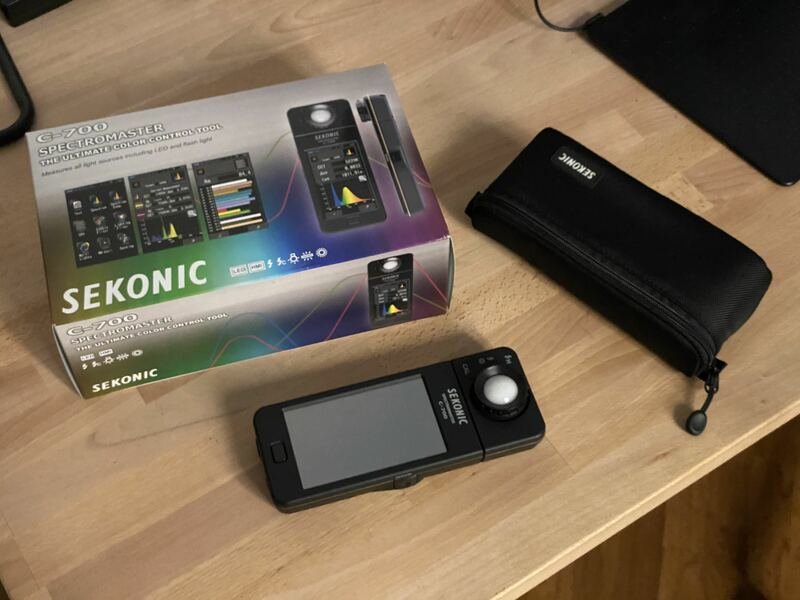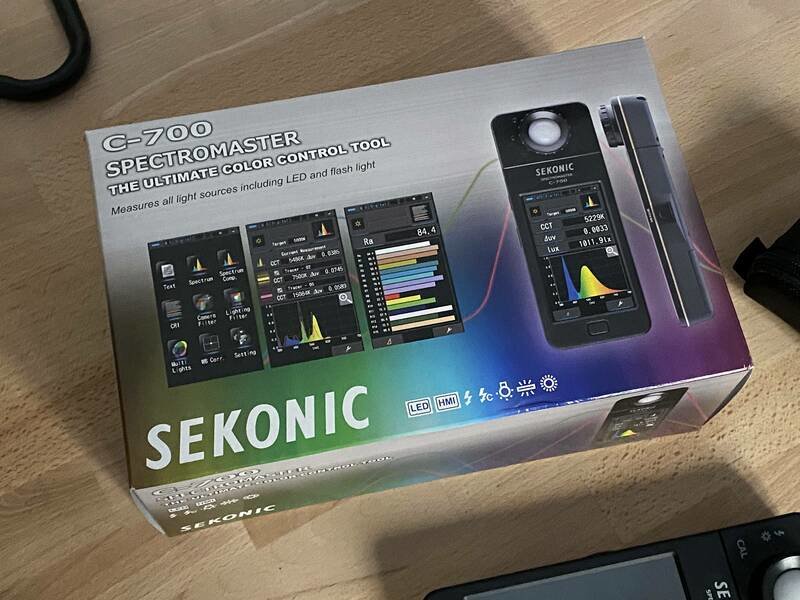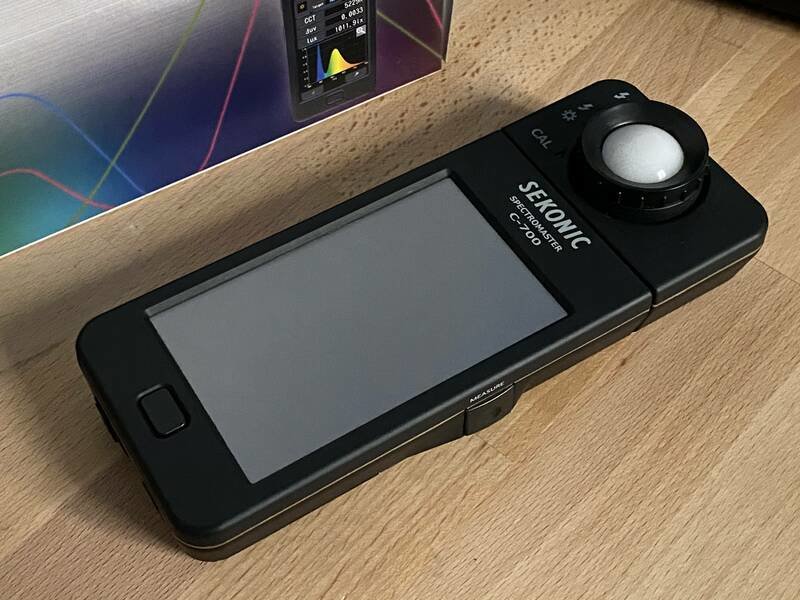Search the Community
Showing results for tags 'metering'.
-
Perfect conditions! Regular import with box and genuine Sekonic pouch. Asking price is €850 If you don't have an EU or UK VIES enabled VAT ID I have to apply local VAT.
-
- sekonic
- spectrometer
-
(and 9 more)
Tagged with:
-
Hello, When you are metering a scene, do you meter for the camera's dynamic range, or for the 6 stops in SDR or the 13+ stops in HDR? For instance, if your camera has 6 stops of highlight dynamic range, and 8 stops of shadow dynamic range, do you keep everything in your scene between those 14 stops or do you keep everything in between the lets say 6 stops of standard dynamic range? I hope this question makes sense! Thanks in advanced to anyone who can help! - Matt
-
Hello everyone, As I consider buying my first light meter and delve deeper into the world of cinematography, there are a few questions I can't seem to find (satisfying) answers for, at least online. I'd really appreciate any help in these matters. Question 1 Why is it so important to define a camera's true native ISO. Not the marketed one but the actual real one. I've learned how to do it it but I still don't understand why I'd do it. As an example (hypothetical), let's say I'm using an Alexa and I come to the conclusion that its real ISO is 400 instead of the proclaimed 800. What am I supposed to do with that? Should I question the way the stops are supposedly distributed between shadows and highlights? Supposedly at ISO800 it's -7/+7 stops of range, did that range now move to 400? Like what's happening here? Also, does it differ from camera to camera, even if it's the same model? Or can I trust the results from tests done from people I know I trust; whether online or otherwise, for that specific model? I understand we must test, test and test. As a novice I can assure you this notion is drilled into our minds by almost every self respecting cinematographer, gaffer, DIT etc. And I am thankful for it. However can't we trust these manufacturers at least a little bit? Question 2 I took a cinematography workshop not too long ago, my first, and was introduced to light meters and how useful they are. Now that I'm about to work on my first couple of projects I can't imagine myself not using one. However. During that workshop several people had the same light meter (mostly Sekonic 858) and, surprise, not all readings were the same. From the same position on the same spot, whether reading incident light or spotting, people were getting (slightly to not-so-slightly) different readings. So here's my question, how can I tell if I can trust my light meter? I live in a country where most people don't use light meters and we don't have any kind of support to send them off to calibration. Any suggestions? In case it's essential to make sure that the light meter is reading accurately, does anyone know of someone or of a service center that does this anywhere not in the Americas? Also, has anyone ever dealt with Sekonic's service center, the one in Oman? Many thanks. Don't judge me too harshly on my trust issues :)
-
Alright I'm having a conundrum this morning as I pack for a weekend in the woods. I really would love to shoot one of my carts of Ektachrome (64T or 100D) I have left. Also... I want to use my newly acquired Nizo 156 Macro as it's a lovely little travel camera and I have the UWL wide angle lens for it as well. Also it has a 220º XL lens (1/28th). I have shot 200T in this camera and it came back great so the camera definitely works. Thing is... it has dumb metering. I've attached an image of what the manual says about how it reads carts. In THEORY... I feel like it should read a 100D cart correctly as 100D as it SAYS it can meter 100D. But when I tested the aperture looking at a building outside my door, it was reading around 2.8ish-4 on the Nizo 156 Macro THEN when I tested that same cart on my Canon 514XL (I've shot Ekta and Provia 100D in the 514XL with great results) and my trusty Canon 814XL-S (only shot 64T in there but it meters everything really), they both read around F8. I even tried Tungsten notching the 100D and got roughly the same results in both (when on tungsten as I don't want any filter engaged). And to make things even more interesting, I realized the 156 Macro's filter switch is just connected to a little rod that tests whether the cart has a notch or not. As in... if you move the switch back and forth, the little rod goes back and forth. So it's not really detecting anything on its own. Thoughts? It must be reading the 100D as 25 or 40ASA (either as Tungsten or B&W... what's the difference in cart??) since it was Why does it say it'll read 100D when clearly it doesn't. How does it detect daylight film? I have seen only a couple examples online with this combo that seem good but no idea how they metered. https://www.youtube.com/watch?v=2WrGfBdKfZs Super 8 metering is crazy.... Wish Kodak would've just made all cameras able to set ASA...
- 2 replies
-
- ektachrome
- nizo
-
(and 4 more)
Tagged with:
-
What is the downside to using an incident light meter to set my exposure for video? I've been doing it for about a month and it has been working well for me so far; but I'm a rookie—those of you with much more experience—what can go wrong in video when measuring light with an incident meter rather than using the various camera exposure tools? I'm mainly concerned with ensuring that faces look the same from shot to shot. The problem I'm trying to solve is that my style generally includes a fair bit of back and edge lighting which often freaks out the waveform monitor, the RGB parade, and the histogram so I have been getting inconsistent brightness levels. Using a light meter is also quicker because I can adjust lights and get a reading immediately rather than running back and forth to the monitor to see what has changed.
-
Just looking to see what tools each of you use in your metering the exposure of a scene. I currently use a combination of a Minolta MK.IV incandescent light meter and the waveform/histogram from the camera itself (in this digital age). I am looking to use a spot meter more for more accurate readings but I am wondering if I should throw some money down on a Minolta or Sekonic. Or just use the spot metering of my Canon 60d SLR instead. What do you find works the best in metering a scene effectively? Cheers!
- 7 replies
-
- Light meter
- Metering
-
(and 3 more)
Tagged with:
-
Just wanted to know how a scene would be metered if your trying to get the correct exposure of the set - not necessarily a particular subject - but the whole shot as a whole. Say this shot for instance. Would you walk all the way up to the empress and incident meter her since all the light will be hitting the dome? Or would you spot read? Love this movie btw beautifully photographed.
- 5 replies
-
- metering
- incident metering
-
(and 1 more)
Tagged with:
-
It's been discussed here before : The internal meter on a Super 8 camera (typically) compensates for the loss of light split off by the prism for the meter and the viewfinder and changes due to focal length. I have read as many threads on this topic as I can but there seems to be one question that has not been asked. When the viewfinder shows an f-stop - is that the value before or after compensation for light loss? I'm using a Nizo Professional but think this a general question.
-
Hi, Im new here and beginner though..But i found that i have more passion on cinematography since i take my first shot using mobile cam for my very 1st short film and my friends appreciated about it. They have named me cinematographer as well..Aha.. But I know that i dont deserve that name and i still have to travel a way more, now im just just with my very 1st step forward. I had take a loan to buy a SLR(Canon 550D) for me and im still paying EMI for it..aha.. Though i have SLR with me but i never experiment anything new because i dont know where to start and how to start. My economic doesnt support me to go for a course.u would have come to know that how i buy my SLR..lol.. All my knowledge about camera and its stuffs are from internet, i.e from the people who shared there kniowledge online.Im so thankfull to them :) What is the result? I have got confidence to put my pix online(http://www.facebook.com/pages/S-pix). And now i'm the DP for a short film :).This is 1st my project i gonna work with my SLR.Im so excited,i have bought cheap tripod and made a shoulder-mount by my own for this project. What help this kid need is...Your support and suggestions for what im going to go through till the end of this project. Thanks in Advance. Suresh










